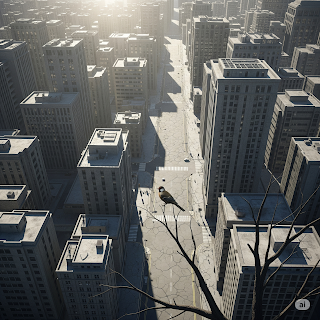A Changing Skyline, A Disappearing Song
Birdsong—once a hallmark of peaceful early mornings—is slowly being drowned out by the sounds of cars, construction, and air conditioners. The reason isn’t just noise. Cities are becoming increasingly hostile habitats for birds, as urbanisation and rising heat stress alter the conditions they once thrived in.
As India and other countries experience rapid urban sprawl, recent studies have shown that the occurrence and diversity of bird species in cities have been significantly impacted. Heatwaves, vanishing green spaces, and man-made concrete jungles have triggered a silent exodus in the avian world.
🌇 What Is Urbanisation Doing to Bird Habitats?
Urbanisation involves replacing natural landscapes with built-up environments: roads, buildings, malls, and dense housing. This transformation impacts birds in multiple ways:
🏗️ Habitat Fragmentation
-
Trees and shrubs are cut down, removing nesting sites.
-
Wetlands and open areas—crucial for many species—are drained or covered.
-
Migration corridors get obstructed, leading to loss of seasonal visitors.
🚧 Pollution & Noise
-
High decibel levels confuse bird communication.
-
Light pollution disrupts nocturnal birds and migratory navigation.
-
Air and water contamination reduces insect and fish populations—essential bird food sources.
🚫 Limited Resources
-
Few places to nest and fewer food sources.
-
Increased competition from adaptable species like pigeons and crows.
-
Exotic plants in urban gardens often don’t attract local pollinators or insects, further lowering food availability.
🔥 Urban Heat Islands: A New Environmental Threat
Urban Heat Island (UHI) effect is the phenomenon where city areas are significantly warmer than surrounding rural zones, primarily due to heat-absorbing materials like asphalt and concrete, and minimal tree cover.
📉 What Heat Stress Does to Birds:
-
Dehydration: Many birds depend on water bodies or dew. Rising heat evaporates these resources.
-
Egg Mortality: High surface temperatures disrupt incubation and can kill unhatched eggs.
-
Behavioral Shifts: Birds become nocturnal or crepuscular, feeding only during cooler hours.
-
Species Replacement: Heat-resilient birds dominate; heat-sensitive, migratory, or insectivorous species decline.
📊 Case Study: Indian Cities and Avian Decline
A 2024 ecological survey across Delhi, Mumbai, Bengaluru, and Hyderabad found:
-
Decline in species richness in dense urban zones by 42%
-
Presence of generalist birds (e.g., pigeons, house sparrows) in 90% of surveyed sites
-
Disappearance of sensitive species like Indian Pitta, Bulbul, and Woodpeckers from inner cities
-
Rooftop gardens had higher bird diversity than built-up zones without green cover
“Species that once thrived near homes now require pockets of green to survive,” notes Dr. A. Menon, urban ecologist at IISc Bangalore.
📍 Species Most Affected by Urbanisation & Heat Stress
| Bird Species | Urban Status | Reason for Decline |
|---|---|---|
| Indian Pitta | Vanishing | Loss of undergrowth & nesting space |
| Purple Sunbird | Migrating | Insect decline, extreme heat |
| Common Tailorbird | Shifting | Habitat fragmentation |
| Rose-ringed Parakeet | Stable | Highly adaptive |
| House Crow | Thriving | Scavenger, heat-resilient |
🌿 The Role of Urban Green Patches and Wetlands
Despite the grim picture, not all hope is lost. Studies show that urban biodiversity hotspots—parks, large gardens, urban lakes—still attract a wide variety of birds.
Key Findings:
-
Tree-lined avenues attract canopy birds like barbets and koels.
-
Urban wetlands are breeding grounds for egrets, kingfishers, and ducks.
-
Native plant species increase insect biodiversity, indirectly supporting birds.
Example: Delhi’s Yamuna Biodiversity Park saw a 27% increase in bird diversity after habitat restoration and waterbody cleaning.
🏙️ Heat-Tolerant Species vs Heat-Vulnerable Birds
Urbanisation filters out species based on adaptability:
Winners:
-
Pigeons
-
House Sparrows
-
Mynas
-
Crows
-
Rock Doves
Losers:
-
Warblers
-
Cuckoos
-
Orioles
-
Flycatchers
-
Owls
Heat-tolerant species tend to be omnivorous, opportunistic, and cavity nesters—traits that serve them well in man-made environments.
💡 What Can Be Done?
While cities can’t reverse development, they can become bird-inclusive through science-backed interventions:
1. Green Roofs & Vertical Gardens
These reduce heat and offer foraging space.
2. Native Landscaping in Public Spaces
Parks filled with native plants and shaded trees provide refuge.
3. Urban Wetland Protection
Preserving stormwater retention areas helps migratory birds and local breeders.
4. Bird-Friendly Architecture
Minimize glass facades, install bird perches, and integrate nesting niches in buildings.
5. Community Participation
-
Install birdbaths and feeders
-
Maintain terrace gardens
-
Support local cleanup drives and green projects
🌐 International Models: What Cities Can Learn
-
Singapore’s Skyrise Greenery Program integrates bird-friendly design into high-rise housing.
-
Barcelona’s Green Corridor Project links parks and greenways to aid animal and bird migration.
-
London’s Big Garden Birdwatch fosters citizen science and data collection.


No comments:
Post a Comment